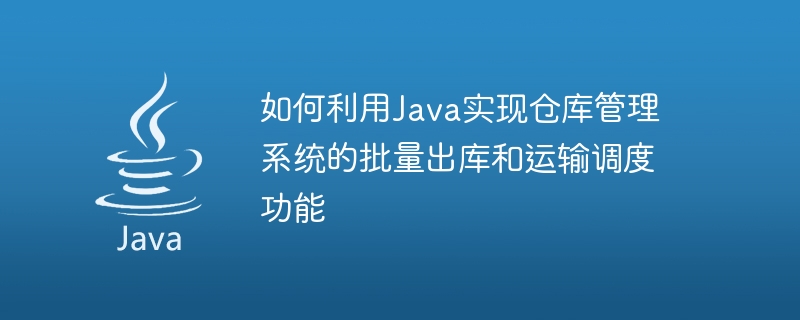Home >Java >javaTutorial >How to use Java to implement the batch outbound and transportation scheduling functions of the warehouse management system

How to use Java to implement the batch outbound and transportation scheduling functions of the warehouse management system requires specific code examples
With the rapid development of e-commerce, warehouse management systems have become It is an indispensable part of the daily operations of the enterprise. One of the core functions of the warehouse management system is batch outbound and transportation scheduling. This article will introduce how to use the Java programming language to implement these functions and provide specific code examples.
First, we need to define some key data structures and classes. Warehouse management systems usually have three main entities: warehouse, merchandise and goods. First define a warehouse class Warehouse, which contains various properties and methods of the warehouse.
public class Warehouse {
private String name;
private List<Goods> goodsList;
public void addGoods(Goods goods) {
// 添加新货物到仓库
}
public void removeGoods(Goods goods) {
// 从仓库中移除货物
}
// 其他方法
}Next, define a product category Goods to represent specific products.
public class Goods {
private String name;
private double price;
private int quantity;
// 其他属性和方法
}In the warehouse management system, batch outbound shipment refers to removing multiple goods from the warehouse at one time. We can add a batch export method to the Warehouse class.
public void batchRemoveGoods(List<Goods> goodsList) {
for (Goods goods : goodsList) {
removeGoods(goods);
}
}Transportation scheduling refers to allocating goods from the warehouse to different transport vehicles for delivery. In order to implement the transportation scheduling function, we need to define a Transportation class to represent the transportation vehicle.
public class Transportation {
private String vehicleNumber;
private List<Goods> goodsList;
public void loadGoods(Goods goods) {
// 将货物装载到运输车辆
}
public void unloadGoods(Goods goods) {
// 卸载货物
}
// 其他属性和方法
}Next, we can add a method to distribute goods to the Warehouse class.
public void allocateGoods(List<Goods> goodsList, List<Transportation> transportationList) {
int i = 0;
for (Goods goods : goodsList) {
transportationList.get(i).loadGoods(goods);
i++;
if (i == transportationList.size()) {
i = 0; // 循环分配货物
}
}
}The above is the code implementation of the core functions of the warehouse management system. Of course, a real warehouse management system also involves many other functions and details, such as inventory management, order processing, etc. These functions need to be expanded and customized according to specific needs in actual projects.
To sum up, using the Java programming language to implement the batch outbound and transportation scheduling functions of the warehouse management system can be accomplished by defining appropriate classes and methods. We can manage warehouses and goods through the Warehouse class, represent transportation vehicles through the Transportation class, and implement batch outbound and transportation scheduling functions through corresponding methods. The code examples provided above can help beginners understand the implementation ideas, but in actual development, more details and specific business requirements need to be considered.
The above is the detailed content of How to use Java to implement the batch outbound and transportation scheduling functions of the warehouse management system. For more information, please follow other related articles on the PHP Chinese website!